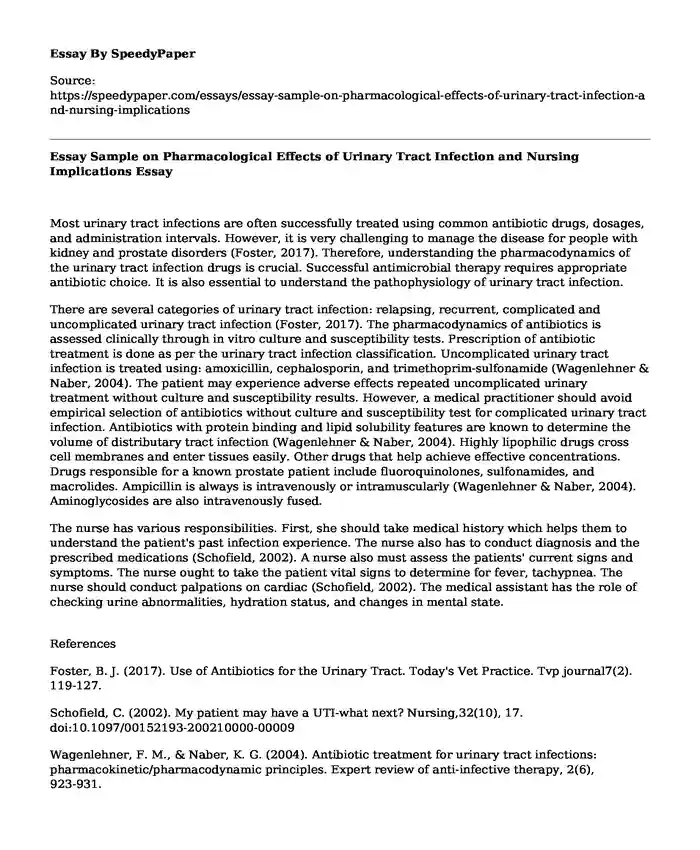
| Type of paper: | Course work |
| Categories: | Nursing Pharmacology |
| Pages: | 2 |
| Wordcount: | 357 words |
Most urinary tract infections are often successfully treated using common antibiotic drugs, dosages, and administration intervals. However, it is very challenging to manage the disease for people with kidney and prostate disorders (Foster, 2017). Therefore, understanding the pharmacodynamics of the urinary tract infection drugs is crucial. Successful antimicrobial therapy requires appropriate antibiotic choice. It is also essential to understand the pathophysiology of urinary tract infection.
There are several categories of urinary tract infection: relapsing, recurrent, complicated and uncomplicated urinary tract infection (Foster, 2017). The pharmacodynamics of antibiotics is assessed clinically through in vitro culture and susceptibility tests. Prescription of antibiotic treatment is done as per the urinary tract infection classification. Uncomplicated urinary tract infection is treated using: amoxicillin, cephalosporin, and trimethoprim-sulfonamide (Wagenlehner & Naber, 2004). The patient may experience adverse effects repeated uncomplicated urinary treatment without culture and susceptibility results. However, a medical practitioner should avoid empirical selection of antibiotics without culture and susceptibility test for complicated urinary tract infection. Antibiotics with protein binding and lipid solubility features are known to determine the volume of distributary tract infection (Wagenlehner & Naber, 2004). Highly lipophilic drugs cross cell membranes and enter tissues easily. Other drugs that help achieve effective concentrations. Drugs responsible for a known prostate patient include fluoroquinolones, sulfonamides, and macrolides. Ampicillin is always is intravenously or intramuscularly (Wagenlehner & Naber, 2004). Aminoglycosides are also intravenously fused.
The nurse has various responsibilities. First, she should take medical history which helps them to understand the patient's past infection experience. The nurse also has to conduct diagnosis and the prescribed medications (Schofield, 2002). A nurse also must assess the patients' current signs and symptoms. The nurse ought to take the patient vital signs to determine for fever, tachypnea. The nurse should conduct palpations on cardiac (Schofield, 2002). The medical assistant has the role of checking urine abnormalities, hydration status, and changes in mental state.
References
Foster, B. J. (2017). Use of Antibiotics for the Urinary Tract. Today's Vet Practice. Tvp journal7(2). 119-127.
Schofield, C. (2002). My patient may have a UTI-what next? Nursing,32(10), 17. doi:10.1097/00152193-200210000-00009
Wagenlehner, F. M., & Naber, K. G. (2004). Antibiotic treatment for urinary tract infections: pharmacokinetic/pharmacodynamic principles. Expert review of anti-infective therapy, 2(6), 923-931.
Cite this page
Essay Sample on Pharmacological Effects of Urinary Tract Infection and Nursing Implications. (2022, Nov 30). Retrieved from https://speedypaper.com/essays/essay-sample-on-pharmacological-effects-of-urinary-tract-infection-and-nursing-implications
Request Removal
If you are the original author of this essay and no longer wish to have it published on the SpeedyPaper website, please click below to request its removal:
- HRM Essay Sample: Changes in Job Motivation
- Meaning of Altruism - Essay Sample
- Check Jamaica Nation Research in Our Free Essay
- Frankenstein by Mary Shelley, Literary Essay Sample
- Andreas Ekstrom: The Moral Bias
- Free Paper Sample on School Policy
- "The Bamboo Stalk" and "For Bread Alone". Paper Example
Popular categories




